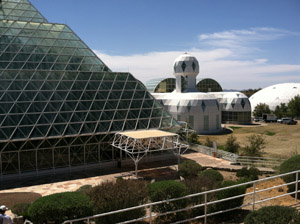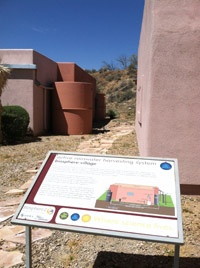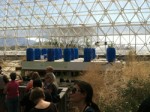A whirlwind week of exploring Biosphere1’s Green Infrastructure and Low Impact Design (LID) throughout Tucson, Arizona brings itself to a conclusion with a journey to the desert home of Biosphere2. Biosphere2 is an Earth systems science research facility owned by the University of Arizona. Its current mission is to serve as a center for research, outreach, teaching and life-long learning about Earth (Biosphere1), its living systems, and its place in the universe.
Biospherians (yes, that’s what they call people who lived in the Biosphere) inhabited the enormous enclosed structure from 1991 to 1993 and then again for six months in 1994. Intervention into the two-year living experiment came when oxygen levels dropped precipitously and Biospherians found they could not cultivate sufficient calories to sustain the more than 65 hours of work each week required to maintain life within the enclosure. While it is no longer inhabited, the enormous (two and a half football fields under glass) structure is now used by the University of Arizona as a collective research facility, and interesting experiments in Earth-sciences are constantly underway. TreePeople’s Edith de Guzman and her husband Jolly joined G3’s Pamela Berstler and Surfrider’s Paul Herzog for a two-hour tour of the facility. Nearly twenty years have passed since the original Biospherians were locked inside, and the various biomes have grown significantly.
Compared with The Eden Project in Cornwall, England, Biosphere2 seems a bit too “engineered” and sterile. But the research conducted within this controlled environment undoubtedly will contribute to a better understanding our fragile, blue world — and that makes it one of the great wonders of our time.






